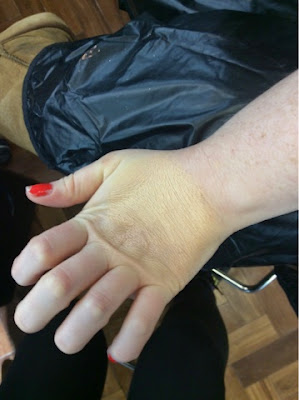Health and Safety: If using a model place apron around the neck to protect clothing.
Always ensure to run a client consultation to check for any infections, allergies or contraindications.
Wash hands thoroughly before touching the clients face.
Allow liquid latex to breath before applying.
Products Used:
- Cleanser, toner and moisturiser
- Supracolour Palette - Red, Yellow, Purple, Blue, Black
- Liquid Latex
- Scar Wax
- Foundation Palette
- Wound Filler
- Fake Blood
- Stipple Sponge
- Tu Plast
- Non Flexible Collodium
- Palette Knife
- Foundation Brush
- Small Brush
- Non Latex Sponge
Process of Creating a Black Eye
(Look the at images of real black eyes for inspiration)
 |
| Old Black Eye |
2. Begin by taking some yellow supracolour on a makeup sponge and apply to the socket of the eye, blending out with the edges of the sponge to create a natural old bruise effect.
3. Using a small makeup brush place red supracolour around the outside of the eye socket and down the natural fold underneath the eye where the skin often darkens when tired.
4. Blend out into the yellow using the makeup sponge, blending the edges is essential to creating a realistic look rather than visible makeup settled on the skin.
5. Taking the same makeup brush work some purple tones into the deeper sections of the eye socket focusing in particular on the lower flesh and bone areas where the bruising would have impacted the most.
6. Blend the colours out again using the sponge.
7. Black may also be applied to darken any desired areas however this must be blended also.
8. The colours and placement would change as the black eye heals therefore on set photographing your work across all stages is essential for consistency.
Evaluation
I feel that creating this black eye was successful as I wanted to create the effect of an older bruising than that of a fresh one. The feedback in class was that I should probably use more purple tones to create a more effective black eye however I wanted the bruising to appear fading, however I do understand why more purple would be necessary for a fresh bruise. In addition to this in future I will probably make the tones of yellow and red bolder and more apparent as despite being vibrant to the naked eye, appear slightly washed out on camera. In future I think it will be necessary to create black eyes through a variety of healing stages to develop my understanding of how the skin texture and tone changes throughout brushing. Despite this I feel my first attempt at creating a black eye was effective and I enjoyed the painterly technique used to apply the makeup to the skin.
Creating Wounds "All about moulding"
 |
| Wounds and Grazes |
2. Optional to apply a layer of spirit gum to attach the latex to the skin however this is not always necessary.
3. Create sausage shape, add to the hand and being moulding the sides down into the skin.
4. Cleanser makes the process easier and blends the edges nicely into the area of skin, it is ideal to use the fingers for this.
5. Cut threw the wax with a palette knife and use the spatula to separate the wax out slightly, rougher edges add for a more authentic look.
6. Apply liquid latex or sealer over the wax and set with a hairdryer on cool.
7. Keeping the area a bit shiny from the latex adds a realistic swollen effect to the wound.
8. Use cleanser again to blend away the edges a little more and this will prevent any harsh edges being created by the latex and makeup.
9. Apply base colour using a foundation that matches the skin tone.
10. Add redness and tone using the supracolour palette.
11. Wound filler may also be added to the inside of the wound - it is a fibrous material that creates the texture of flesh.
12. Apply fake blood with a baby bud to the centre of the wound. Dirt or pus may also be added.
Creating Scratches
1. Ensure the area of skin is clean.
2.Taking a red toned supracolour or fake blood dab some onto a stipple sponge.
3. Swipe the stipple sponge across the chosen area to create grazed effect.
4. This is particularly effective on areas of bone such as knuckles and joints.
5. Dirt may also be added for effect.
Scars
1. Ensure the area is clean.
2. Making sure the end of the Tu-Plast nip is clean, drag the nose across the area of skin.
3. Use a hairdryer on cool setting to set the Tu-Plast.
4. Using a pin create roughness (optional).
5. Makeup as usual.
6. Apply fixer spray.
Split Lip
1. Make sure the area of skin chosen is clean.
2. Apply foam barrier to the lip.
3. Paint Non-flexible Collodium onto the skin.
4. Using spatula to create dent in the skin and dry with hair dryer if needed.
5. Apply more layers if needed.






